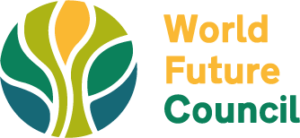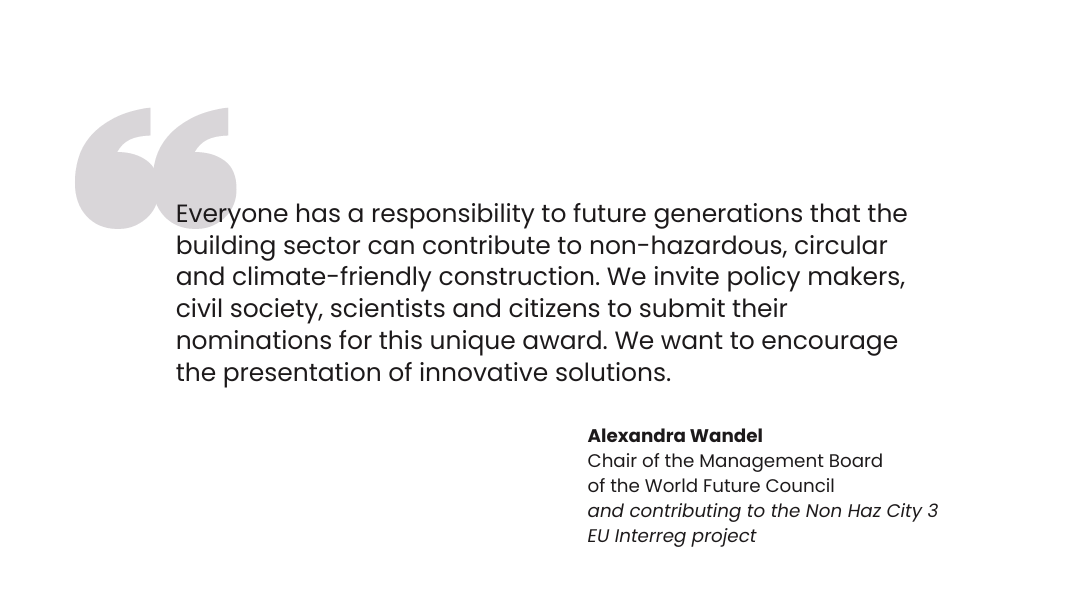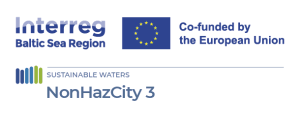The inaugural NonHazCity Building Award stands as the premier accolade in policy recognition within the Baltic Sea Region for outstanding practices in construction at the national, regional, or local levels. Its primary goal is to spotlight policies that safeguard individuals and the environment by addressing hazardous chemicals in buildings while promoting circularity, toxicity-free environments, and climate neutrality. This award seeks to inspire citizens, decision-makers, and businesses, providing a platform to showcase pioneering solutions. We take on the role of coordinating and presenting this prestigious award as part of the NonHazCity 3 Project.
Why tox-free, circular and climate neutral in the building sector?
Chemistry is vital in construction for time management, quality and sustainability. In Europe, there’s a focus on eco-friendly practices, such as using local, low-carbon materials, emphasizing insultation and renewable energy. To support future reuse, construction materials should be low in harmful substances, documented for recyclers.
What are we looking for?
Policies, laws and legal frameworks that help create a tox-free, circular and climate neutral building environment encompassing existing and new buildings, refurbishments and extensions.
Laws, policies, frameworks, standards, guidelines and action plans for buildings can be subnational, regional or local in nature and can:
· deliver identifiable improvements (Gold Award);
· show policy progress (Silver Award)
· be replicable under similar circumstances
Questions to answer:
Non-toxic: Is there full knowledge about chemicals/composition of construction materials, is smart procurement used or other policies/standards protecting humans and environment from toxic substances?
Circularity: Is there a policy incentivising a smart use of existing structures as much as possible, flexibility for a long lifetime, creating the feedstock material for future circularity?
Climate change: Construction material: Is carbon positive material from the region used?
The Selection Process
Our research team will evaluate the nominated policies and prepare a report for the jury with candidates. A regional jury of experts will select the winner(s).
The Award Ceremony
The winner(s) of the Non Haz City Building Award will be celebrated at a high-level award ceremony in 2025 in Riga hosted by Riga City Council. The award ceremony will be convened by the WFC in partnership with the City Council of Tallin and Riga and Baltic Environment Forum (Germany, Estonia and Latvia).
The NonHazCity 3 Project
Saving the Baltic See is a challenge because relevant emissions are released from various sources and originate from all of the bordering states. Across the board the construction sector seems to be one important such source. Within the EU countries, this pollution should be governed by the EUs chemicals legislation REACH and the Water Framework Directive WFD. However, these two were never intended to target the construction sector specifically, and the sector itself has numerous other challenges including material shortages and energy efficiency, hence its reluctance.
In previous NonHazCity projects other partners already developed material educating about undesirable chemicals in everyday products such as cosmetics, detergents, plastics and food and even material to self-check entire households. Important parts deal with options to substitute harmful products by safe alternatives including establishing green public procurement (GPP) criteria.
In the NonHazCity 3 project, we join in to continue this very journey, helping to shed light onto the building sector, also politically. Sadly oftentimes buildings do contribute to indoor-air pollution, but there are many more hidden sources of toxics in buildings to be identified and substituted. While at the same time energy efficiency must also be stepped up during these key times to curb climate change and cut fossil fuel dependency, the construction sector is also an important source of waste, contributing currently around 50% materialwise in many countries.
Our contribution
Therefore within the project, partners are assisting this key-sector to close as many loops as possible. Aiming for more circularity does again entail the substitution of harmful chemicals.
Within this project the WFC will be responsible to create a NonHazCity building award, incentivising municipalities to adjust and implement some of the required key improvements and to secure the necessary political attention and leadership for the sector.
Jointly with our partners, WFC also drafts and tests training material and toolboxes to support municipalities as well as architects, suppliers of building materials and construction companies – all situated in the countries around the Baltic Sea so they can serve as models and help spread the solutions across the entire region.
Within the NonHazCity 3 project, more than 20 partner entities from eight different countries across the Baltic Sea Region are learning from collaboration with each other to raise awareness of hazardous substances in construction material. The project is led jointly by Riga City Council and the NGO Baltic Environmental Forum BEF and is funded via the EU’s Interreg Baltic Sea Region programme until the End of 2025.
Potential International Impact
The distressing state of the Baltic Sea had already been addressed at UN level with the adoption of the Helsinki Commission to protect it back in 1974. 30 years later and the accession of more countries from Eastern Europe, the EU gave it another try with the Baltic Sea strategy. Since tangible improvements are insufficient till this day, an fresh action plan was has been launched in 2021. Besides the disruptive effect of climate change, both waste and chemical pollution which had already been addressed in Helcom are decisive factors. Besides excessive pesticide intake on the one hand, there is also concern about undesirable chemical pollution, mainly from consumption and construction activities. Our current Non Haz City III project addresses the construction sector and activates public procurement as a driver that has so far been underrated. In many places the public sector is driving about 50% of construction activity.
Within this EU Interreg Project, the World Future Council Foundation has the task to craft and carry out a Non Haz City Building Award within the Project Region and coordinates the creation of training modules for target groups such as municipalities, architects as well as suppliers of raw material and construction companies. Thereby we enable and promote solutions of municipalities for the management of construction projects and support their dissemination throughout the Baltic Sea region.
Links:
https://interreg-baltic.eu/about/
https://www.eusbsr.eu/action-plan





